
Waterloo, Nova Scotia
Encyclopedia
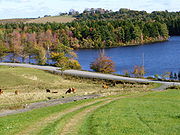
Lunenburg County, Nova Scotia
Lunenburg County is a county located on the South Shore of the Canadian province of Nova Scotia, It ranges from Hubbards to the east and Vogler's Cove to the west.-History:...
. The community extends approximately 10 kilometers from Route 210
Nova Scotia Route 210
Route 210 is a collector road in the Canadian province of Nova Scotia.It is located in Lunenburg County and the Region of Queens Municipality, connecting Middlefield on Trunk 8 to Newcombville on Route 325-Communities:...
to the Queens County line and is 20 kilometers from the commercial hub of Bridgewater
Bridgewater, Nova Scotia
Bridgewater is a town in Lunenburg County, Nova Scotia, Canada, at the navigable limit of the LaHave River. It is the largest town in the South Shore region. While the majority of the South Shore's economy is based upon the tourist trade, Bridgewater is more a commercial and industrial centre and...
. The Waterloo Road runs through the community providing a picturesque alternative to Route 210 when travelling between Newcombville and Greenfield
Greenfield, Queens County, Nova Scotia
Greenfield is a community in the Canadian province of Nova Scotia, located in the Region of Queens Municipality. The sawmill in Greenfield, founded in 1832, is one of the oldest family-run sawmill businesses in North America.....
.
First Peoples and the newcomers
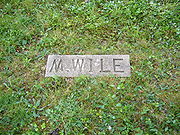
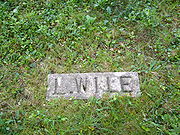
Otter
The Otters are twelve species of semi-aquatic mammals which feed on fish and shellfish, and also other invertebrates, amphibians, birds and small mammals....
, mink
Mink
There are two living species referred to as "mink": the European Mink and the American Mink. The extinct Sea Mink is related to the American Mink, but was much larger. All three species are dark-colored, semi-aquatic, carnivorous mammals of the family Mustelidae, which also includes the weasels and...
, and other animals for fur" (DesBrisay, 1895). Some time before 1870, when early deeds show transfers of land in the community, the first settlers received large land grants of 50 to 150-acre parcels from Great Britain
Great Britain
Great Britain or Britain is an island situated to the northwest of Continental Europe. It is the ninth largest island in the world, and the largest European island, as well as the largest of the British Isles...
before and around the time of Canadian Confederation
Canadian Confederation
Canadian Confederation was the process by which the federal Dominion of Canada was formed on July 1, 1867. On that day, three British colonies were formed into four Canadian provinces...
.
Historical perspectives
The European roots of the community are predominately from small German states which are comprised by the GermanyGermany
Germany , officially the Federal Republic of Germany , is a federal parliamentary republic in Europe. The country consists of 16 states while the capital and largest city is Berlin. Germany covers an area of 357,021 km2 and has a largely temperate seasonal climate...
of today and from the region known as Montbéliard
Montbéliard
Montbéliard is a city in the Doubs department in the Franche-Comté region in eastern France. It is one of the two subprefectures of the department.-History:...
in eastern France. Waterloo Settlement's first settlers were sons and daughters of second and third-generation German and Montbéliardian immigrants brought to Nova Scotia as loyal citizens to the British crown in 1750–52. The French-speaking Montbéliardians were considered good candidates to emigrate since they were known to be "very frugal, as well as strong independent laborers" (Withrow, 2002). As for the Germans (and likely the Swiss), Judge Debrisay quotes a number of stereotypes and impressions that developed and existed of the first German immigrants up to 1895, at least 140 years after their arrival. "They are a big, square-shouldered, deep-chested race. They do not talk much, but look as though they thought—easy going, and good tempered... they are hearty eaters, but they are not fussy and finikin over their food... so long as the dish is wholesome, and there is sufficient of it, they are satisfied... in the sensuous arts of painting and sculpture, the Germans are poor. In the ennobling arts of literature and music they are great, and this fact provides a key to their character. They are simple, earnest, homely, genuine people. They do not laugh much, but when they do they laugh deep down. They are slow, but so is a deep river... . The Germans believe in themselves, and respect themselves".
Historical significance of the region
These German, Swiss, and French settlers arrived just prior to the tumultuous years when Nouvelle France was being defeated by the British, resulting in the first Treaty of Paris (1763)Treaty of Paris (1763)
The Treaty of Paris, often called the Peace of Paris, or the Treaty of 1763, was signed on 10 February 1763, by the kingdoms of Great Britain, France and Spain, with Portugal in agreement. It ended the French and Indian War/Seven Years' War...
. Many Acadians were expelled in 1755 and these German Protestant immigrants initially were the new population sought to outbalance the French and Mi'kmaq influence in the region—both of which were Catholic
Catholic
The word catholic comes from the Greek phrase , meaning "on the whole," "according to the whole" or "in general", and is a combination of the Greek words meaning "about" and meaning "whole"...
(Withrow, 2002). There was at least another connection between these Acadians and the Germans. Because there was a food shortage in the Lunenburg
Lunenburg
Lunenburg was the form customary in 18th-century English for Lüneburg, the city and region in Germany. It therefore occurs in several placenames in North America.-Canada:*Lunenburg, Nova Scotia*Lunenburg, Nova Scotia...
area where the German settlers were granted their first land, the British encouraged them to travel to the Acadians' newly seized and vacated land in what is now the Annapolis Valley
Annapolis Valley
The Annapolis Valley is a valley and region in the Canadian province of Nova Scotia. It is located in the western part of the Nova Scotia peninsula, formed by a trough between two parallel mountain ranges along the shore of the Bay of Fundy.-Geography:...
and herd their abandoned livestock back to Lunenburg. Between July 30 and September 3, 1756, 282 of the settlers were involved in the drive by either retrieving the animals or tending to the chores of those who went. Three of those surnames involved were later to be prominent Waterloo names: Krause, Vienot, and Weil. The community was also settled by a Black Loyalist
Black Loyalist
A Black Loyalist was an inhabitant of British America of African descent who joined British colonial forces during the American Revolutionary War...
by the surname of Lavender. L & E Lavender received a grant of land south of Matthew Lake and farmed it as did the other settlers.
German and Montbéliardian community roots: Wile, Hirtle, Crouse, and Veinot
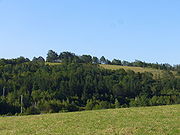
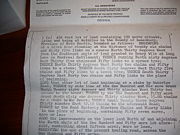
Drumlin
A drumlin, from the Irish word droimnín , first recorded in 1833, is an elongated whale-shaped hill formed by glacial ice acting on underlying unconsolidated till or ground moraine.-Drumlin formation:...
in the area, overlooking Mack Lake (later renamed "Matthew Lake"), which he cleared to build his home and break up for cropland.
Michael was soon followed by George Hirtle (DesBrisay, 1895), who eventually was granted 600 acres (2.4 km²) in total in the Long Lake area. According to an 1892 deed, the most westerly portion of the community around Long Lake was called "Montreal Settlement." The third man to arrive was his brother, James Hirtle, who was granted a total of 364 acres (1.5 km²) south of Long Lake and north of the Waterloo Road, also in the Montreal Settlement area. Michael's nephews Absalom (1831–1892) and Henry Wile (1817–1889) soon were granted land in the same area, 735 acres (3 km²) and 100 acre (0.404686 km²) respectively. In one example, Charles Tupper
Charles Tupper
Sir Charles Tupper, 1st Baronet, GCMG, CB, PC was a Canadian father of Confederation: as the Premier of Nova Scotia from 1864 to 1867, he led Nova Scotia into Confederation. He later went on to serve as the sixth Prime Minister of Canada, sworn in to office on May 1, 1896, seven days after...
, later to become the sixth Prime Minister
Prime minister
A prime minister is the most senior minister of cabinet in the executive branch of government in a parliamentary system. In many systems, the prime minister selects and may dismiss other members of the cabinet, and allocates posts to members within the government. In most systems, the prime...
of Canada, in his role as the as provincial secretary granted Absalom Wile 150 acre (0.607029 km²) of his final 735 in 1858 while Nova Scotia was still a colony
Colony
In politics and history, a colony is a territory under the immediate political control of a state. For colonies in antiquity, city-states would often found their own colonies. Some colonies were historically countries, while others were territories without definite statehood from their inception....
.
Michael's brothers joined him in the settlement area. George (1804–1880) was granted 250 acres (1 km²) in the most eastern part of the settlement around Fire Lake and St. George Lake; William (1813–1900) and Isaac (1825–1914) were granted land in the Mack Lake area gaining 194 and 325 acres (1.3 km²) respectively and sharing a 200 grant. Mack Wile (the lake's namesake) was the grandson of William.
Through intermarriage with the first settlers, other surnames became prominent in the community such as the Montbéliardian Veinot (from Leopold Vienot who arrived on the ship "Betty" in 1752 and Crouse (Hans George Krause, arrived in 1752 on the 1752 ship Gale or John Jacob Krause, Ship Pearl, 1752). Absalom's daughter Lois married William Roxway Crouse. Absalom's granddaughter Sadie Wile married Albert St. Clair Veinot.
Earliest marked grave: Susannah E. Fiendel Wile
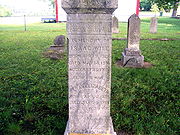
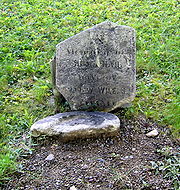
Bridgewater, Nova Scotia
Bridgewater is a town in Lunenburg County, Nova Scotia, Canada, at the navigable limit of the LaHave River. It is the largest town in the South Shore region. While the majority of the South Shore's economy is based upon the tourist trade, Bridgewater is more a commercial and industrial centre and...
was only an idea. Susanna was the second wife of Andrew Wile, the first of two sons born to John Frederick "Weil", the progenitor of the Wiles of Nova Scotia. Andrew's oldest son (from his first wife Regina Getson) John Frederick, built the second house built in Bridgewater along with his brother Garrett, and framed by John Vienot (DesBrisay, 1895). With the passing of Regina Getson, Andrew Sr. married Susanna E. Fiendel. She became the stepmother of Andrew's ten previous children, of whom only about half were adult at the time. Susanna had ten more children of her own. It was her step-grandsons, Absalom and Henry who were granted the land in Montreal Settlement. It was her sons Michael, George, William, and Isaac who settled Waterloo Settlement. Her grandson Dean Wile started the Wile Carding Mill
Wile Carding Mill
The Wile Carding Mill is a defunct carding mill, in Bridgewater, Nova Scotia, Canada. The mill is now operated as a museum.This water-powered mill was owned and operated by the Wile family from 1860 to 1968. The Wiles ran the mill but employed a number of workers, usually unmarried women, to...
in Bridgewater and also donated the land for Brookside Cemetery in Bridgewater. The presence of Susannah Fiendel Wile's grave in the Waterloo Cemetery indicates that she may have spent her last years with her sons and their families in Waterloo Settlement instead of in Wileville where her husband Andrew and she had lived together.
Eight Hirtles marry eight Wiles
John "Michael" Hirtle (1786–1840) and his wife Anna Maria Rhuland lived in the nearby community of Newcombville and ran a saw mill with George Hirtle in the early 19th century (Desbrisay, 1895). Michael and Anna Maria's seven daughters all married Wiles—even one of their sons, George Benjamin Hirtle (b. 1814) married one of the boys' sisters, Sophia Dorothea Wile, and was quite likely the second person to come to Waterloo Settlement (Desbrisay, 1895). Michael's daughter, Mary Ann (b. 1810) married Andrew and Susanna Fiendel Wile's oldest boy, John George. George's brother, George Michael, Waterloo's first settler of European descent, married Mary Ann's sister Lucy Salome (b.1813). William, another brother of George's married Catherine (b. 1819), another sister. David, a younger brother of George married Mary Elizabeth (b. 1816), yet another sister.These brothers' oldest half-brother, John Frederick Wile (oldest son of Andrew and his first wife, Regina Getson), had seven sons, three of whom married the rest of Michael Hirtle's daughters: Henry, John, and James. Henry Wile married Sophia Amelia (b. 1822); John married Sarah Ann (b. 1824); and finally James married Barbara (b. 1826), the last of the seven sisters.
Most of these Hirtle–Wile marriages constituted the first of Waterloo Settlement families. George farmed at the junction of the Waterloo Rd and Chelsea Rd; George "Michael" on the highest hill overlooking Matthew Lake; William's farm overlooked Frederick Lake to the south; Sophia and George farmed in the Montreal Settlement-Long Lake area; and Henry and Sophia farmed the land overlooking Long Lake.
Education

Framing (construction)
Framing, in construction known as light-frame construction, is a building technique based around structural members, usually called studs, which provide a stable frame to which interior and exterior wall coverings are attached, and covered by a roof comprising horizontal ceiling joists and sloping...
and interior preparations.
By the Act of 1864, Nova Scotia was divided into local school sections (Woods, 1936). As early as 1894, the Waterloo School was one of those sections known as Waterloo School Section No. 92 (Waterloo, 1894). School board meeting minutes
Minutes
Minutes, also known as protocols, are the instant written record of a meeting or hearing. They typically describe the events of the meeting, starting with a list of attendees, a statement of the issues considered by the participants, and related responses or decisions for the issues.Minutes may be...
from 1895–97 speak to the deliberations over whether to enforce the Compulsory School Act. The motion to enforce the Act was defeated at each of these three annual meetings. Generally during those early years, most of the resolutions put forward involved the school building and maintenance; the letting of contracts for "fire making" and provision of firewood were common themes (Waterloo, 1894–98). Each year considerable meeting time was spent in the nomination of board members and trustees. Students travelled by foot to school. For those from Montreal Settlement, the four kilometer round trip was difficult in the winter (Hubley, 2002). The last year the Waterloo School operated was 1959–60. After that, Grade 1–8 students were bussed to the Wileville School and Grades 8–12 to Hebbville
Hebbville, Nova Scotia
Hebbville is an incorporated village bordering the town of Bridgewater in Lunenburg County, Nova Scotia, Canada. The village borders numerous other unincorporated communities as well as Fancy Lake on its southern border....
School. Some teachers who served over the years were Maggie Herman from 1893–1895; Blanche Whitman, 1896–97; D. Marie Sarty, 1929–1931; Roger Sarty, 1934–35; Cora Wile, 1935–36; and Shirley Fraser, 1950-?). School salaries ranged from $100 a year in 1896 to $325 by 1936. In the early 1960s, a K-6 school was built in Newcombville for area students including children from Waterloo.
Another education entity in the community was the Department of Agriculture
Agriculture
Agriculture is the cultivation of animals, plants, fungi and other life forms for food, fiber, and other products used to sustain life. Agriculture was the key implement in the rise of sedentary human civilization, whereby farming of domesticated species created food surpluses that nurtured the...
organization known as 4-H
4-H
4-H in the United States is a youth organization administered by the National Institute of Food and Agriculture of the United States Department of Agriculture , with the mission of "engaging youth to reach their fullest potential while advancing the field of youth development." The name represents...
. A club was started in the early 1950s in the Waterloo school, mostly as a garden club with approximately five members. In the 1960s, the club amalgamated with the Lapland 4-H Garden Club. Finally in 1971, the clubs separated and the Waterloo 4-H Club was reestablished with 13 members. The members were required to write and make public speeches; enter agricultural exhibits in the South Shore Exhibition ; compete in judging events of agricultural products; and show the handling of cattle and horses in the exhibition rings.
Religion
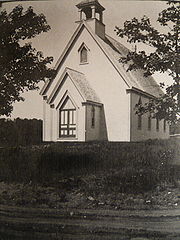
Baptist
Baptists comprise a group of Christian denominations and churches that subscribe to a doctrine that baptism should be performed only for professing believers , and that it must be done by immersion...
being the most common. St. Michael's Lutheran Church was organized on March 12, 1889 under the leadership of Rev. F. A. Kohlse. For ten years the congregation met in the hall built on the second floor above of the schoolhouse (the hall was used every fifth Sunday by the Baptists) (Veinot, 2008). In c. 1899, the congregation built and dedicated a church across the road from the school. During the month of July 1939, the church was renovated and redecorated. The members supplied the labor and the many gifts and memorials that were unveiled in a rededication ceremony on July 28, 1939. Rev. Douglas A. Conrad, the pastor of the Waterloo church, hosted the many visitors and guest speakers during the five days of celebration. (Bridgewater, 1939)
The continuity of the Lutheran faith is still evident today in the community although change has occurred over the years. This adherence to the faith and a continuing desire for a local place of worship was evident in the results of the vote taken at the Planning Committee (c. 1969) that addressed the potential merger of five regional congregations. During that vote, only 20% of the St. Michael's representatives approved of the merger. Nevertheless, the amalgamation took place with the majority of approval (approximately 51%) of the voting representatives of the five churches. The building of a new All Saints Lutheran Church in Newcombville formalized the future meeting place of the region's Lutherans (Resolutions, 1969). St. Michael's was dismantled in the early 1970s. The church's bell has been permanently mounted next to the cemetery.
Language
English is the first language of the community and county. As with most regions in the Canada, dialects exist. Some interesting dialectal forms of words and unique phrases are spoken in the community and county at large. Although these uses are not universal, they are widespread. Some words are spoken without a conventional hard "r" consonant such as "ova" (over), "hause" (horse), "aw" (our), and "ca" (car). Others are spoken with an unconventional use of vowels such as "tamarra" (tomorrow), "sure" (sure pronounced the shore), and "ta" (to). Some contractions and word clips have been created to accommodate those missing in the English language such as "daren't" (dare not), "'mon" (come on), and "'bout" (about).Sometimes little-known words are used such as "chesterfield" (for sofa), or "scrooch" with "oo" sounding like foot (scrooch oo's normally pronounced like "too"—means to bend or cower) to describe the movements of an animal or futile human efforts; or the use of right in "right sultry" weather as to say it is "certainly" sultry (where right is used in the fashion of "right enough" or "undeniably" right). One phrase, to "be short-taken" (meaning the sudden and unplanned need to find a restroom), appears to be borrowed from the British phrase, to "be taken short" or "caught short."
A number of new words and phrases have found their way into the vernacular as well. For example, cutting wood into pieces or chunks is "junking it up" (perhaps from "chunking it up"); standing with one's back toward someone is "standing back to"; babies sometimes "crex" and cry (whimper or whine); and "squauze" as the past tense for squeeze; and a "sneaky" person is someone who is a picky eater.
Inhabitants and longevity: 92+
EducationEducation
Education in its broadest, general sense is the means through which the aims and habits of a group of people lives on from one generation to the next. Generally, it occurs through any experience that has a formative effect on the way one thinks, feels, or acts...
, hard work, and initiative have all benefited this small community in unique ways. The community has produced business owners, civil servants, educators, farmers, a financial advisor, a journeyman
Journeyman
A journeyman is someone who completed an apprenticeship and was fully educated in a trade or craft, but not yet a master. To become a master, a journeyman had to submit a master work piece to a guild for evaluation and be admitted to the guild as a master....
, a professor
Professor
A professor is a scholarly teacher; the precise meaning of the term varies by country. Literally, professor derives from Latin as a "person who professes" being usually an expert in arts or sciences; a teacher of high rank...
, a curriculum
Curriculum
See also Syllabus.In formal education, a curriculum is the set of courses, and their content, offered at a school or university. As an idea, curriculum stems from the Latin word for race course, referring to the course of deeds and experiences through which children grow to become mature adults...
writer, and a veteran
Veteran
A veteran is a person who has had long service or experience in a particular occupation or field; " A veteran of ..."...
. The community has shared in the longevity
Longevity
The word "longevity" is sometimes used as a synonym for "life expectancy" in demography or known as "long life", especially when it concerns someone or something lasting longer than expected ....
trend that statisticians say exists disproportionally in the County of Lunenburg compared to other world statistics. Absalom Wile's stepmother, Susannah Fiendel, lived to be 92. One son of Absalom Wile, Wiswell Wile, had a daughter, Ella Hintz (1900–2003) from Wileville who lived to be an active 103.
Remnants of German culture: yokes and sauerkraut
The first German settlers came to Lunenburg County 258 years ago. Little remains of the German language and cultural practices. However, a few German implements and foods linger. The German head yoke is still used for yoking oxen at showmanship pulls and the German claw hoe can still be found in various tool sheds. German sauerkrautSauerkraut
Sauerkraut , directly translated from German: "sour cabbage", is finely shredded cabbage that has been fermented by various lactic acid bacteria, including Leuconostoc, Lactobacillus, and Pediococcus. It has a long shelf-life and a distinctive sour flavor, both of which result from the lactic acid...
is cut from cabbage
Cabbage
Cabbage is a popular cultivar of the species Brassica oleracea Linne of the Family Brassicaceae and is a leafy green vegetable...
and turnip
Turnip
The turnip or white turnip is a root vegetable commonly grown in temperate climates worldwide for its white, bulbous taproot. Small, tender varieties are grown for human consumption, while larger varieties are grown as feed for livestock...
. Another food is the Lunenburg sausage
Sausage
A sausage is a food usually made from ground meat , mixed with salt, herbs, and other spices, although vegetarian sausages are available. The word sausage is derived from Old French saussiche, from the Latin word salsus, meaning salted.Typically, a sausage is formed in a casing traditionally made...
made from ground pork and beef, spiced with coriander
Coriander
Coriander is an annual herb in the family Apiaceae. Coriander is native to southern Europe and North Africa to southwestern Asia. It is a soft, hairless plant growing to tall. The leaves are variable in shape, broadly lobed at the base of the plant, and slender and feathery higher on the...
and stuffed into the entrails of the hog. The pudding
Pudding
Pudding most often refers to a dessert, but it can also be a savory dish.In the United States, pudding characteristically denotes a sweet milk-based dessert similar in consistency to egg-based custards, though it may also refer to other types such as bread and rice pudding.In the United Kingdom and...
version is spiced with summer savory
Summer savory
Summer savory is the better known of the savory species. It is an annual, but otherwise is similar in use and flavor to the perennial winter savory...
and then cooked (Veinot, 2008).
The arrival of modern conveniences
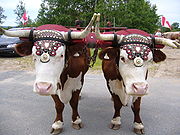
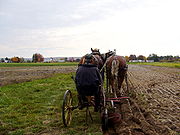
Draft horse
A draft horse , draught horse or dray horse , less often called a work horse or heavy horse, is a large horse bred for hard, heavy tasks such as ploughing and farm labour...
eventually replaced the oxen. The last known draft horse to work the land was "Bill", a black Belgian owned by Ivan Wile. Today oxen and horse teams are a traditional icon of Lunenburg County heritage. "Pulls" are well-attended events in the South Shore Exhibition at Bridgewater each summer.
Electricity
Electricity
Electricity is a general term encompassing a variety of phenomena resulting from the presence and flow of electric charge. These include many easily recognizable phenomena, such as lightning, static electricity, and the flow of electrical current in an electrical wire...
did not arrive in Waterloo until the 1950s. The entire line was installed during the winter of 1949–50 and on one day in April at 4:30 PM residents saw all the lights come on in the homes that had been wired. Prior to that, kerosene lamps were used in the house and lanterns with rags in fat or kerosene
Kerosene
Kerosene, sometimes spelled kerosine in scientific and industrial usage, also known as paraffin or paraffin oil in the United Kingdom, Hong Kong, Ireland and South Africa, is a combustible hydrocarbon liquid. The name is derived from Greek keros...
were used for chores.
Within a year of the electric power installation, telephone line was strung as well on the same poles. A "party line" system was used where a contact was made with another person in the party by turning a handle (or later a dial) on the side or face of the box a certain combination of one or two short or long rings. Privacy was afforded on an honor system where if the line was already in use by someone in the party, the "receiver" was placed back on the hook and the would-be caller tried later.
The "dirt" road that served the community for over 100 years was paved in the 1980s. Because the road needed proper sloping and drainage, it had been subject to frost heaves and became practically impassable in the spring. More than once school buses became mired in the middle of the road and required towing from other buses or tractors as late as the 1970s. Beginning in 1983, the road was widened, raised, ditched and finally paved in four stages: Highway 210 to the Veinot Rd; Veinot Rd to the Bolivar Rd; Bolivar Rd to Long Lake; and finally Long Lake to the Queens County line by 1987.
Physical features of the land
The dominant physical features of the community are cleared drumlins, wetlands known as "swamps" and three lakes: Frederick Lake, Matthew Lake (earlier Mack Lake, likely after Mack Wile, son of Allan Wile, later named Matthew after Matthew Carver, a landholder near the western edge of the lake), and Long Lake. The drumlins provided the best cultivatable land to the original settlers who grew fodderFodder
Fodder or animal feed is any agricultural foodstuff used specifically to feed domesticated livestock such as cattle, goats, sheep, horses, chickens and pigs. Most animal feed is from plants but some is of animal origin...
and commercial crops. One large wetland is known as the Turner Bog. Though the land was too wet for farming and roads, it was granted to the Nova Scotia Central Railway (see more at Halifax and Southwestern Railway
Halifax and Southwestern Railway
The Halifax and Southwestern Railway was a historic Canadian railway operating in the province of Nova Scotia. The H&SW was created in spring 1901 when William Mackenzie and Donald Mann approached the provincial government with plans to finish the abortive plans for a railway from Halifax to...
) to provide wood for infrastructure and possible line expansion (Cameron, 1999).
Living with the land: quilts and stumps
The task of clearing the settlement's first land was one of a studied process. The first task was to cut and gather into piles what they called the "underwood" (now called "undergrowthUndergrowth
Undergrowth usually refers to the vegetation in a forest, which can obstruct passage through the forest. The height of undergrowth is usually considered to be 0.3 – 3 m . Undergrowth can also refer all vegetation in a forest, which isn't in the canopy....
") with an axe or a brush hook. The best of the large trees and heavy wood was cut next—often pine and spruce—which were rolled aside until winter for hauling to the mill and cutting for building materials for the house and barn (According to the c.1881 Ambrose Church Map, Waterloo had no less than three saw mills). Michael Wile mentioned the size of "rock maple
Maple
Acer is a genus of trees or shrubs commonly known as maple.Maples are variously classified in a family of their own, the Aceraceae, or together with the Hippocastanaceae included in the family Sapindaceae. Modern classifications, including the Angiosperm Phylogeny Group system, favour inclusion in...
" being two and three feet thick and the oak
Oak
An oak is a tree or shrub in the genus Quercus , of which about 600 species exist. "Oak" may also appear in the names of species in related genera, notably Lithocarpus...
and ash being of "immense size" (Desbrisay, 1895). Some of this wood was use for firewood
Firewood
Firewood is any wood-like material that is gathered and used for fuel. Generally, firewood is not highly processed and is in some sort of recognizable log or branch form....
and the straighter wood for fence posts. The rest of the larger unwanted wood was left to dry for later burning.
When these trees were cut, the choppers "were usually very careful to leave the stumps about two feet high but no higher" (Martin 1974). This allowed two wheeled carts to pass over them but still left them high enough to catch hold of when being pulled out by oxen. Usually the stumps were left for two or three years until partially rotted when they were more easily pulled from the soil.
Lucy, Michael's wife, illustrated this process when she said how she used to "take her little children in a big basket to the field where [she] was reaping or doing other work, and spread a quilt
Quilt
A quilt is a type of bed cover, traditionally composed of three layers of fiber: a woven cloth top, a layer of batting or wadding and a woven back, combined using the technique of quilting. “Quilting” refers to the technique of joining at least two fabric layers by stitches or ties...
in between the stumps and put them on it, and place another quilt above them for shade" (Desbrisay, 1895).
Once the land was cleared, it was burnt in May and planted immediately. Planting the potatoes, cucumbers, corn and pumpkins was hard work since the soil often had many rocks and roots requiring the most effective tool: a sharp stick. Turnip and grain seed was sown by hand and covered with soil scratched up by the "burnt-land harrow
Harrow (tool)
In agriculture, a harrow is an implement for breaking up and smoothing out the surface of the soil. In this way it is distinct in its effect from the plough, which is used for deeper tillage. Harrowing is often carried out on fields to follow the rough finish left by ploughing operations...
" made from the crotch of a tree with protruding spikes. This ox drawn harrow was triangular with spikes slanted toward the back so as not to get stuck between the stumps and rocks. For a year or two after the burn, the Wiles and Hirtles would have enjoyed the rich ash-filled, weed-free soil. Michael Wile refers to this kind of land when he said he wore his new moose skin trousers "in the burnt land" (Desbrisay, 1895). After two or three years, the crops were rotated to another piece of burnt land leaving the depeated soil either for rough pasture or the seeding down to hay (Martin, 1974).
Natural resources and economy
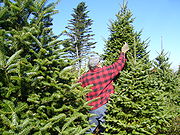
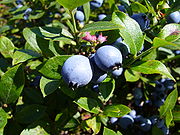
Interview
An interview is a conversation between two people where questions are asked by the interviewer to obtain information from the interviewee.- Interview as a Method for Qualitative Research:"Definition" -...
, Michael Wile refers to his wheat
Wheat
Wheat is a cereal grain, originally from the Levant region of the Near East, but now cultivated worldwide. In 2007 world production of wheat was 607 million tons, making it the third most-produced cereal after maize and rice...
, a crop not planted in recent times. Michael and the other first farmers were first preoccupied with producing bread
Bread
Bread is a staple food prepared by cooking a dough of flour and water and often additional ingredients. Doughs are usually baked, but in some cuisines breads are steamed , fried , or baked on an unoiled frying pan . It may be leavened or unleavened...
with their own flour
Flour
Flour is a powder which is made by grinding cereal grains, other seeds or roots . It is the main ingredient of bread, which is a staple food for many cultures, making the availability of adequate supplies of flour a major economic and political issue at various times throughout history...
since the cost of imported wheat was prohibitive. Michael Wile said that the first flour he used in the settlement was from his own wheat (According to the c.1881 Ambrose Church Map, Waterloo had two gristmill
Gristmill
The terms gristmill or grist mill can refer either to a building in which grain is ground into flour, or to the grinding mechanism itself.- Early history :...
s). The growing of wheat in the county was a difficult undertaking since the climate
Climate
Climate encompasses the statistics of temperature, humidity, atmospheric pressure, wind, rainfall, atmospheric particle count and other meteorological elemental measurements in a given region over long periods...
often didn't permit proper ripening and the quality of the crop
Crop
Crop may refer to:* Crop, a plant grown and harvested for agricultural use* Crop , part of the alimentary tract of some animals* Crop , a modified whip used in horseback riding or disciplining humans...
sometimes yielded low quality flour. In 1845, a large setback to wheat-growing occurred with the scourge of wheat midge
Midge
A midge is a very small, two-winged flying insect. "Midge" may also refer to:-Real:* Midge Costanza , American politician* Mildred Gillars , aka "Midge", American broadcaster of Nazi propaganda during World War II...
Thecodiplomis mosellana Gehin. The larva
Larva
A larva is a distinct juvenile form many animals undergo before metamorphosis into adults. Animals with indirect development such as insects, amphibians, or cnidarians typically have a larval phase of their life cycle...
e from this microorganism
Microorganism
A microorganism or microbe is a microscopic organism that comprises either a single cell , cell clusters, or no cell at all...
destroyed the grain
GRAIN
GRAIN is a small international non-profit organisation that works to support small farmers and social movements in their struggles for community-controlled and biodiversity-based food systems. Our support takes the form of independent research and analysis, networking at local, regional and...
kernels
Seed
A seed is a small embryonic plant enclosed in a covering called the seed coat, usually with some stored food. It is the product of the ripened ovule of gymnosperm and angiosperm plants which occurs after fertilization and some growth within the mother plant...
as their developed (Martin, 1974).
Michael also refers to tapping maples "easily get[ting] three barrels of sap
Sap
Sap may refer to:* Plant sap, the fluid transported in xylem cells or phloem sieve tube elements of a plant* Sap , a village in the Dunajská Streda District of Slovakia...
out of one large maple
Maple
Acer is a genus of trees or shrubs commonly known as maple.Maples are variously classified in a family of their own, the Aceraceae, or together with the Hippocastanaceae included in the family Sapindaceae. Modern classifications, including the Angiosperm Phylogeny Group system, favour inclusion in...
... ma[king] two hundred pounds
Pound (mass)
The pound or pound-mass is a unit of mass used in the Imperial, United States customary and other systems of measurement...
of maple sugar
Maple sugar
Maple sugar is a traditional sweetener in the northeastern United States and Canada, prepared from the sap of the sugar maple tree.-Preparation:...
in a season." This tradition has been continued by Michael Wile's ancestors.
Wildlife was especially plentiful in the early days of the settlement—especially moose
Moose
The moose or Eurasian elk is the largest extant species in the deer family. Moose are distinguished by the palmate antlers of the males; other members of the family have antlers with a dendritic configuration...
. Michael Wile identified the land as "great moose country" where the community hunters killed upwards to 10 in a season—some of which weighed 800 pounds (Desbrisay, 1895).
Since the mid-20th century wild blueberries have been cultivated on the Isaac Wile Hill and Balsam Fir
Balsam Fir
The balsam fir is a North American fir, native to most of eastern and central Canada and the northeastern United States .-Growth:It is a small to medium-size evergreen tree typically tall, rarely to tall, with a narrow conic crown...
Christmas tree
Christmas tree
The Christmas tree is a decorated evergreen coniferous tree, real or artificial, and a tradition associated with the celebration of Christmas. The tradition of decorating an evergreen tree at Christmas started in Livonia and Germany in the 16th century...
s have been grown in various parts of the community. After the first three autumn frosts which set the needles, the trees are traditionally cut in November. Research is currently being done in Truro, Nova Scotia
Truro, Nova Scotia
-Education:Truro has one high school, Cobequid Educational Centre. Post-secondary options include a campus of the Nova Scotia Community College, as well as the Nova Scotia Agricultural College in the neighboring town of Bible Hill.- Sports :...
to develop a tree which will not drop its needles after being cut. This is key to an industry which exports 80 percent of its product to the USA—a market that is steadily become interested in artificial trees that don't drop needles.
Much pulpwood
Pulpwood
Pulpwood refers to timber with the principal use of making wood pulp for paper production.-Applications:* Trees raised specifically for pulp production account for 16% of world pulp production, old growth forests 9% and second- and third- and more generation forests account for the balance...
and timber
Timber
Timber may refer to:* Timber, a term common in the United Kingdom and Australia for wood materials * Timber, Oregon, an unincorporated community in the U.S...
has been harvested from the community especially since the Mersey Pulp Mill
Pulp mill
A pulp mill is a manufacturing facility that converts wood chips or other plant fibre source into a thick fibre board which can be shipped to a paper mill for further processing. Pulp can be manufactured using mechanical, semi-chemical or fully chemical methods...
was built in 1929 in Liverpool, Nova Scotia
Liverpool, Nova Scotia
Liverpool is a Canadian community and former town located along the Atlantic Ocean of the Province of Nova Scotia's South Shore. It is situated within the Region of Queens Municipality which is the local governmental unit that comprises all of Queens County, Nova Scotia...
(Bowater, 2007). Red Spruce
Red Spruce
Picea rubens is a species of spruce native to eastern North America, ranging from eastern Quebec to Nova Scotia, and from New England south in the Adirondack Mountains and Appalachians to western North Carolina.-Physical description:...
, Black Spruce
Black Spruce
Picea mariana is a species of spruce native to northern North America, from Newfoundland west to Alaska, and south to northern New York, Minnesota and central British Columbia...
and Balsam Fir
Balsam Fir
The balsam fir is a North American fir, native to most of eastern and central Canada and the northeastern United States .-Growth:It is a small to medium-size evergreen tree typically tall, rarely to tall, with a narrow conic crown...
are the most common species harvested after it matures in approximately 30 to 40 years. In most cases, the shallow layers of topsoil
Topsoil
Topsoil is the upper, outermost layer of soil, usually the top to . It has the highest concentration of organic matter and microorganisms and is where most of the Earth's biological soil activity occurs.-Importance:...
and grey clay
Clay
Clay is a general term including many combinations of one or more clay minerals with traces of metal oxides and organic matter. Geologic clay deposits are mostly composed of phyllosilicate minerals containing variable amounts of water trapped in the mineral structure.- Formation :Clay minerals...
layers beneath the forest do not support a tree's long term growth or promote good drainage
Drainage
Drainage is the natural or artificial removal of surface and sub-surface water from an area. Many agricultural soils need drainage to improve production or to manage water supplies.-Early history:...
in the local area. The community is rich in shale
Shale
Shale is a fine-grained, clastic sedimentary rock composed of mud that is a mix of flakes of clay minerals and tiny fragments of other minerals, especially quartz and calcite. The ratio of clay to other minerals is variable. Shale is characterized by breaks along thin laminae or parallel layering...
which when blasted and crushed provides various grades of road and building materials.
Recreation: continuity and change
The community hall was and remains the center of collective recreationRecreation
Recreation is an activity of leisure, leisure being discretionary time. The "need to do something for recreation" is an essential element of human biology and psychology. Recreational activities are often done for enjoyment, amusement, or pleasure and are considered to be "fun"...
. Some of the events have changed and some continue in forms that reflect the current times in Lunenburg County.
One popular event from early times until the 1990s was the annual Strawberry
Strawberry
Fragaria is a genus of flowering plants in the rose family, Rosaceae, commonly known as strawberries for their edible fruits. Although it is commonly thought that strawberries get their name from straw being used as a mulch in cultivating the plants, the etymology of the word is uncertain. There...
Supper, celebrating the county's berry harvest. This event brought the community together to socialize and raise funds for the upkeep of the hall. In the 1940s, tables were set up outside the schoolhouse in the yard. The women worked in the kitchen passing the food out the window to those waiting on tables. The men stood around socializing about the various work projects they were involved in. Some of these event coordinators were Mrs. Lionel Wile, Mrs. Carl Wile, Mrs. Austin Bolivar, Mrs. Veinot, Mrs. Maurice Wile, and Mrs. Ivan Wile. In more recent times, all the serving and dining happened in the hall with visitors often lined up outside waiting for a seat; the serving and organizing was done by relatives of those individuals mentioned above.

